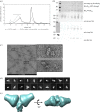The lipid linked oligosaccharide polymerase Wzy and its regulating co-polymerase, Wzz, from enterobacterial common antigen biosynthesis form a complex
- PMID: 36944376
- PMCID: PMC10030265
- DOI: 10.1098/rsob.220373
The lipid linked oligosaccharide polymerase Wzy and its regulating co-polymerase, Wzz, from enterobacterial common antigen biosynthesis form a complex
Abstract
The enterobacterial common antigen (ECA) is a carbohydrate polymer that is associated with the cell envelope in the Enterobacteriaceae. ECA contains a repeating trisaccharide which is polymerized by WzyE, a member of the Wzy membrane protein polymerase superfamily. WzyE activity is regulated by a membrane protein polysaccharide co-polymerase, WzzE. Förster resonance energy transfer experiments demonstrate that WzyE and WzzE from Pectobacterium atrosepticum form a complex in vivo, and immunoblotting and cryo-electron microscopy (cryo-EM) analysis confirm a defined stoichiometry of approximately eight WzzE to one WzyE. Low-resolution cryo-EM reconstructions of the complex, aided by an antibody recognizing the C-terminus of WzyE, reveals WzyE sits in the central membrane lumen formed by the octameric arrangement of the transmembrane helices of WzzE. The pairing of Wzy and Wzz is found in polymerization systems for other bacterial polymers, including lipopolysaccharide O-antigens and capsular polysaccharides. The data provide new structural insight into a conserved mechanism for regulating polysaccharide chain length in bacteria.
Keywords: Wzy; lipid; oligosaccharides; polymerase; regulating.
Conflict of interest statement
We declare we have no competing interests.
Figures





References
Publication types
MeSH terms
Substances
Associated data
Grants and funding
LinkOut - more resources
Full Text Sources
Molecular Biology Databases
Research Materials

